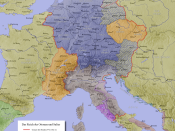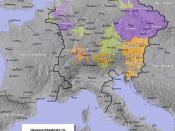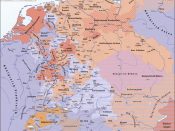Thirty Years' War
Began: 1618
Ended: 1648
Notes: An extended conflict between Protestants and Roman Catholics
General Character of the War
There were many territorial, dynastic, and religious issues that figured in the outbreak and conduct of the war. The extent of religious motives is debated, but cannot be dismissed, particularly in explaining individual behavior. Throughout the war there were shifting alliances and local peace treaties. The war as a whole may be considered a struggle of German Protestant princes and foreign powers (France, Sweden, Denmark, England, the United Provinces) against the unity and power of the Holy Roman Empire as represented by the Hapsburgs, allied with the Catholic princes, and against the Hapsburgs themselves.
The war began with the resistance and eventual revolt of Protestant nobles in Bohemia, which was under Hapsburg domination, against the Catholic king Ferdinand (later Holy Roman Emperor Ferdinand II). It spread through Europe because of the constitutional frailty of the Holy Roman Empire, the inability of the German states to act in concert, and the ambitions of other European powers.
BOHEMIAN PERIOD 1618-1620
Each side was organized in separate factions; the Catholics in the Holy League and the Protestants in the Evangelical Union. The spark that ignited the explosion came when the Archbishop of Prague ordered the destruction of a Protestant church. When the king ignored the protests and appeals from the masses, in a typical Bohemian custom of throwing renegade officials out of a window, the people seized two of the kings royal governors, and threw them out of a palace window. Civil war ensued and spread throughout Europe. The Bohemian Protestants deposed Catholic king Ferdinand and chose Protestant Frederick. In a twist of fate, the ousted king Ferdinand later became Holy Roman Emperor which gave him the necessary power to crush the...


